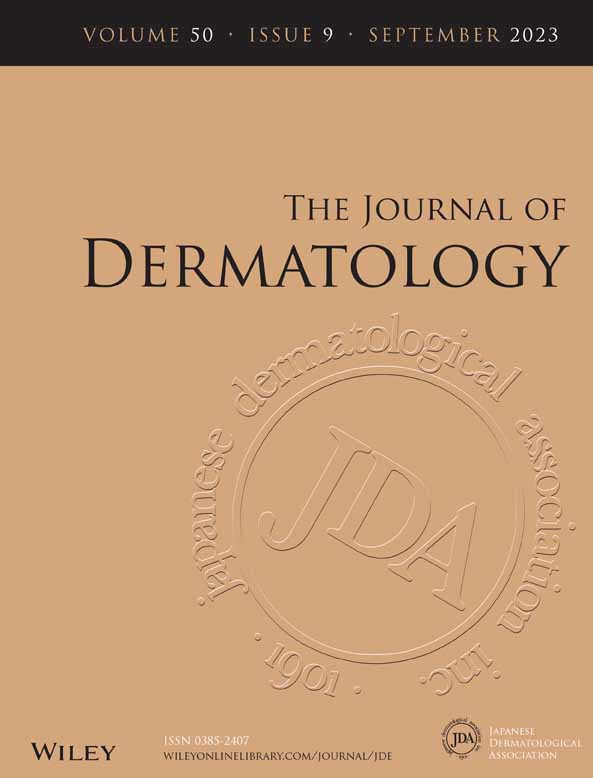A Japanese case of Vörner-type palmoplantar keratoderma caused by a novel KRT1 variant
Satoshi Nakamizo
Department of Dermatology, Kyoto University Graduate School of Medicine, Kyoto, Japan
Search for more papers by this authorTeruasa Murata
Department of Dermatology, Hyogo College of Medicine, Nishinomiya, Japan
Search for more papers by this authorYoshihiro Ishida
Department of Dermatology, Kyoto University Graduate School of Medicine, Kyoto, Japan
Search for more papers by this authorSatomi Aoki
Department of Dermatology, Keio University School of Medicine, Shinjuku, Japan
Search for more papers by this authorTakashi Sasaki
Center for Supercentenarian Medical Research, Keio University School of Medicine, Shinjuku, Japan
Search for more papers by this authorAkiharu Kubo
Department of Dermatology, Keio University School of Medicine, Shinjuku, Japan
Division of Dermatology, Department of Internal Related, Kobe University Graduate School of Medicine, Kobe, Japan
Search for more papers by this authorCorresponding Author
Kenji Kabashima
Department of Dermatology, Kyoto University Graduate School of Medicine, Kyoto, Japan
Correspondence
Kenji Kabashima, Department of Dermatology, Kyoto University Graduate School of Medicine, 54 Shogoin-Kawahara, Sakyo, Kyoto 606-8507, Japan.
Email: [email protected]
Search for more papers by this authorSatoshi Nakamizo
Department of Dermatology, Kyoto University Graduate School of Medicine, Kyoto, Japan
Search for more papers by this authorTeruasa Murata
Department of Dermatology, Hyogo College of Medicine, Nishinomiya, Japan
Search for more papers by this authorYoshihiro Ishida
Department of Dermatology, Kyoto University Graduate School of Medicine, Kyoto, Japan
Search for more papers by this authorSatomi Aoki
Department of Dermatology, Keio University School of Medicine, Shinjuku, Japan
Search for more papers by this authorTakashi Sasaki
Center for Supercentenarian Medical Research, Keio University School of Medicine, Shinjuku, Japan
Search for more papers by this authorAkiharu Kubo
Department of Dermatology, Keio University School of Medicine, Shinjuku, Japan
Division of Dermatology, Department of Internal Related, Kobe University Graduate School of Medicine, Kobe, Japan
Search for more papers by this authorCorresponding Author
Kenji Kabashima
Department of Dermatology, Kyoto University Graduate School of Medicine, Kyoto, Japan
Correspondence
Kenji Kabashima, Department of Dermatology, Kyoto University Graduate School of Medicine, 54 Shogoin-Kawahara, Sakyo, Kyoto 606-8507, Japan.
Email: [email protected]
Search for more papers by this author
Supporting Information
| Filename | Description |
|---|---|
| jde16815-sup-0001-TableS1.xlsxExcel 2007 spreadsheet , 9.5 KB |
Supporting Information Table S1. |
Please note: The publisher is not responsible for the content or functionality of any supporting information supplied by the authors. Any queries (other than missing content) should be directed to the corresponding author for the article.
REFERENCES
- 1Koch L. Exploring human genomic diversity with gnomAD. Nat Rev Genet. 2020; 21: 448.
- 2Terron-Kwiatkowski A, Terrinoni A, Didona B, Melino G, Atherton DJ, Irvine AD, et al. Atypical epidermolytic palmoplantar keratoderma presentation associated with a mutation in the keratin 1 gene. Br J Dermatol. 2004; 150: 1096–103.
- 3Bunick CG, Milstone LM. The X-ray crystal structure of the keratin 1-keratin 10 helix 2B heterodimer reveals molecular surface properties and biochemical insights into human skin disease. J Invest Dermatol. 2017; 137: 142–50.
- 4Liu XP, Ling J, Xiong H, Shi XL, Sun X, Pan Q, et al. Mutation L437P in the 2B domain of keratin 1 causes diffuse palmoplantar keratoderma in a Chinese pedigree. J Eur Acad Dermatol Venereol. 2009; 23: 1079–82.
- 5Protonotarios N, Tsatsopoulou A. Naxos disease: cardiocutaneous syndrome due to cell adhesion defect. Orphanet J Rare Dis. 2006; 1: 4.




